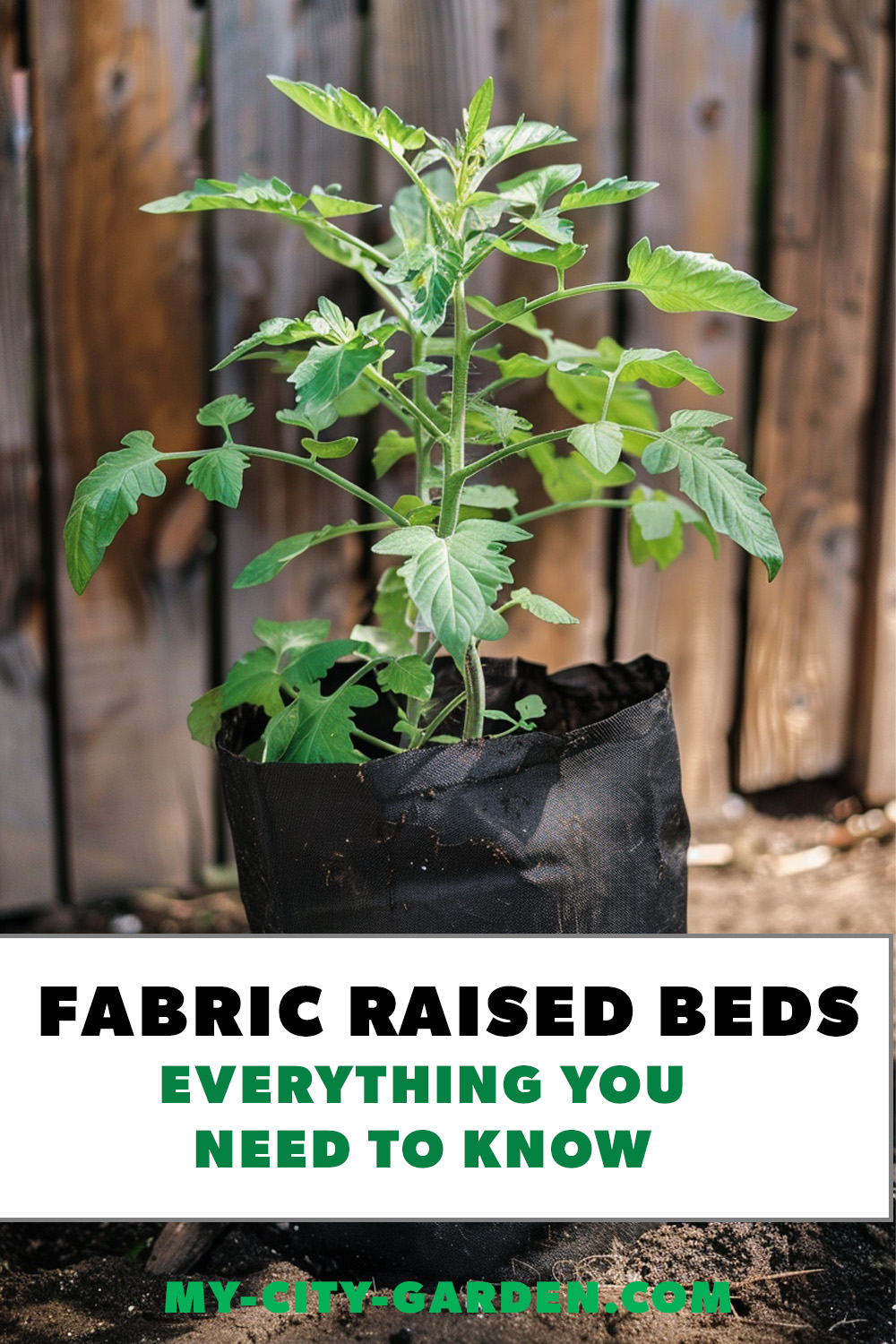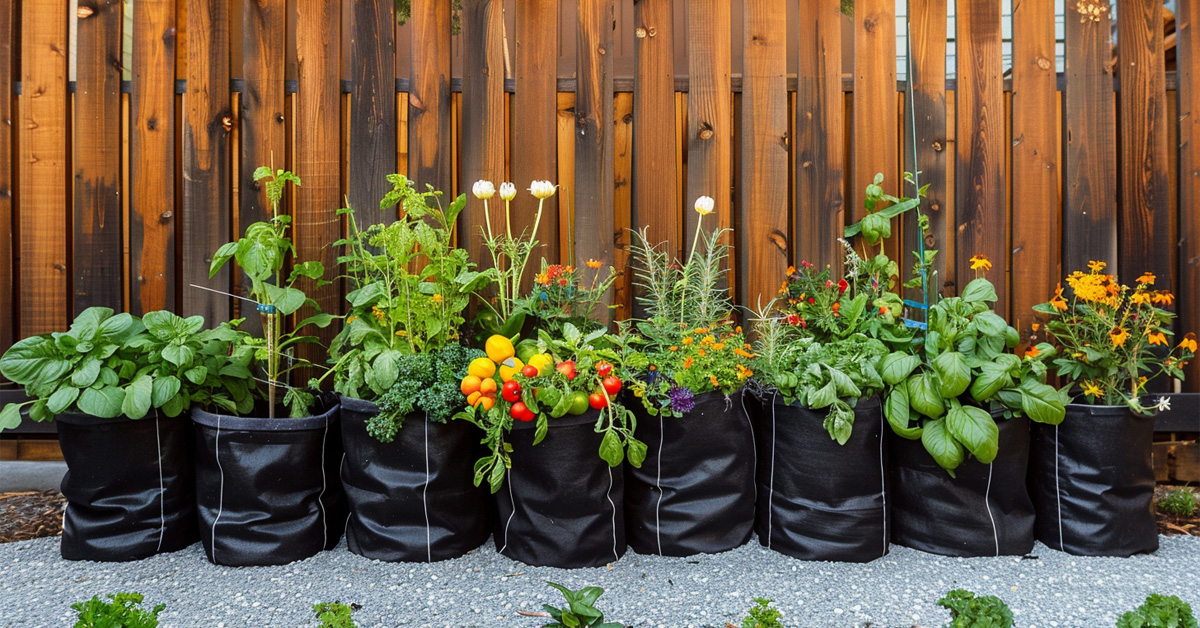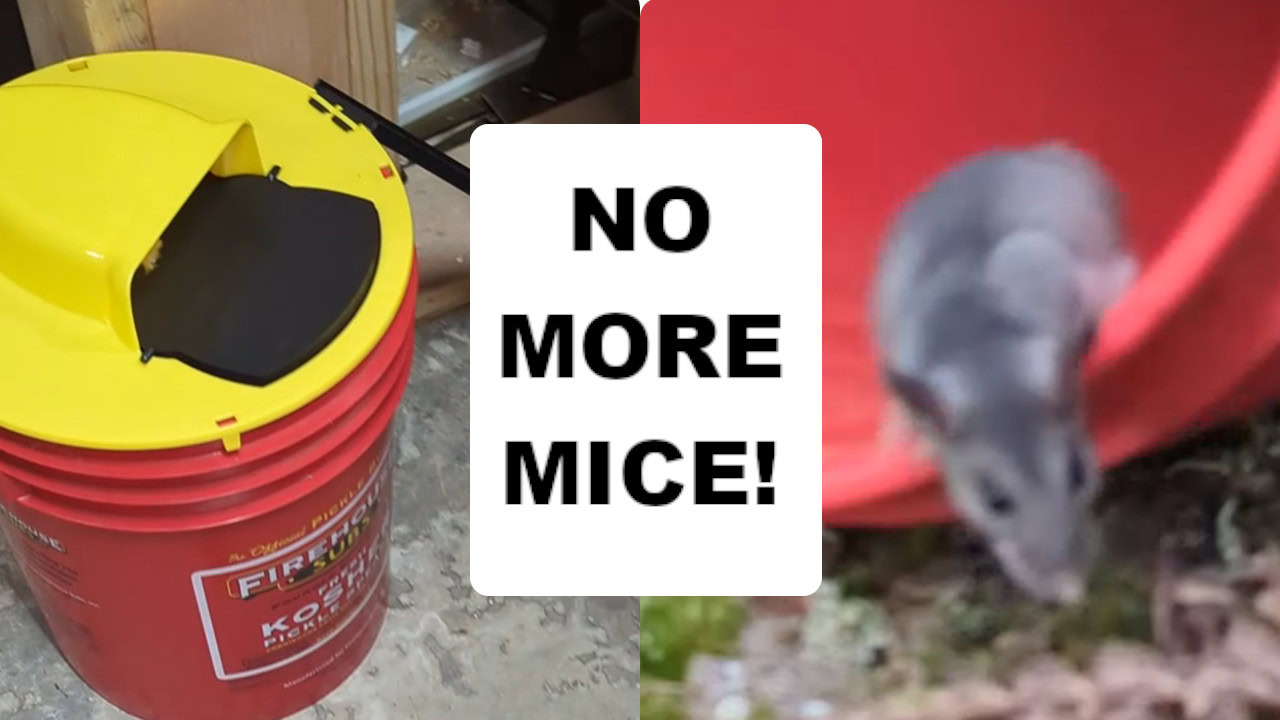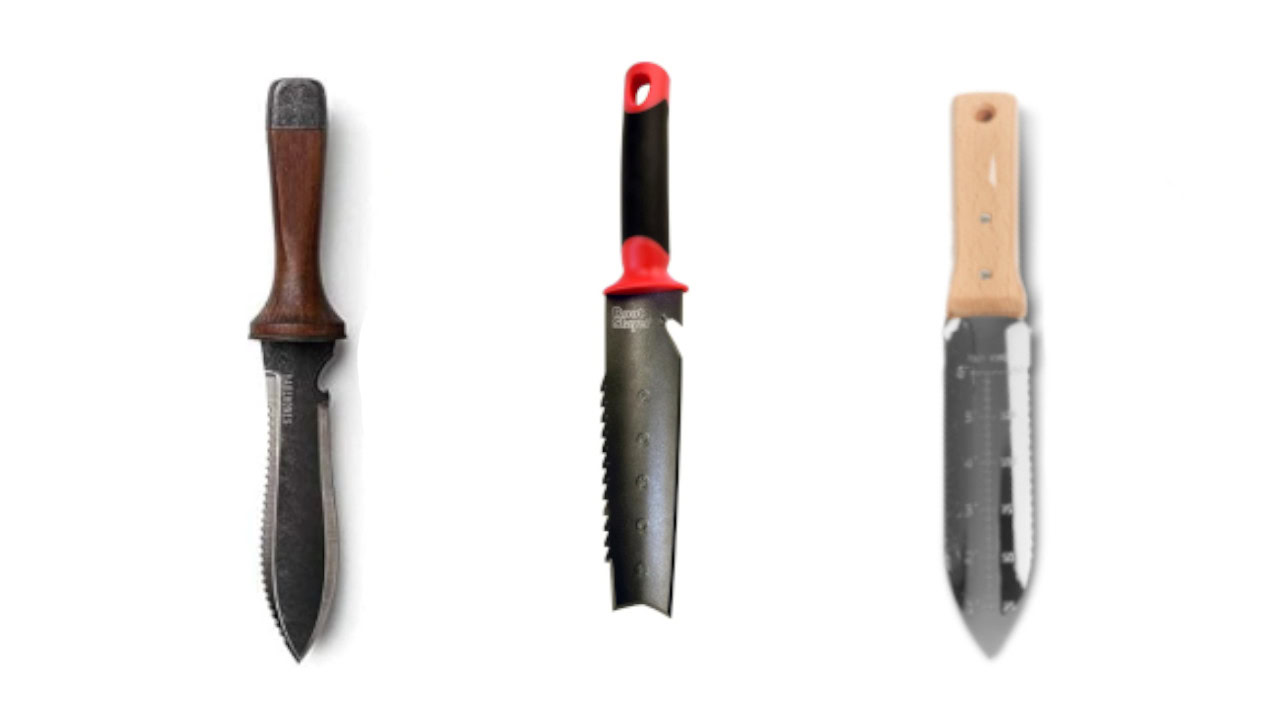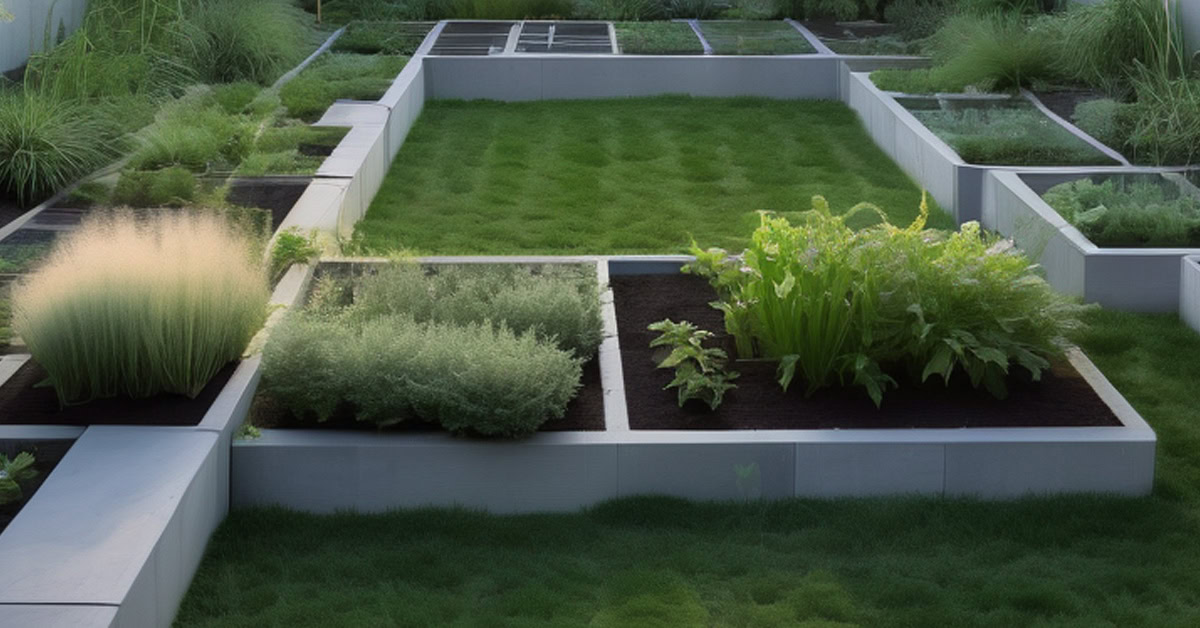Fabric garden pots are a great way to quickly build a raised garden bed, especially in small spaces or on a patio.
Perfect for spaces where you can’t build permanent garden beds, or traditional raised beds, fabric garden beds offer numerous benefits, such as enhanced plant growth, improved drainage and aeration, and the ability to maximize space.
In this beginner’s guide, we will explore everything you need to know about fabric garden beds, from their definition and types to their benefits, challenges, and considerations. We will also provide a step-by-step guide to setting up your own fabric garden bed and offer tips for maximizing your gardening space. By the end of this guide, you’ll be well-equipped to start your own fabric garden bed and enjoy the many benefits it brings.
The Basics Of Fabric Grow Bags
Fabric garden beds, also known as fabric pots or grow bags, are one way of doing raised bed or container gardening that utilizes a container made of breathable fabric. These containers provide an ideal environment for plant growth by promoting root development and allowing for better aeration and drainage.
Definition and Overview
Fabric garden beds are essentially raised beds made of breathable fabric materials. They come in various shapes and sizes, including rectangular, square, and round options. The fabric used is typically made from geotextiles, such as polyester or polypropylene, which are durable and UV resistant. Fabric garden beds are designed to hold soil and plants, allowing for easy gardening in a confined space. They are a popular choice for both professional and amateur gardeners due to their versatility and convenience.
What Are Fabric Grow Beds Made Of?
Fabric grow bags for container gardening are usually made of a durable geotextile that easily allows water and air to flow through it. For gardening the fabric is typically a non-woven, BPA-free polypropylene that is safe for growing vegetables and other edible plants in.
Benefits of Using Fabric Grow Bags For Raised Bed Gardens
Fabric garden beds offer a range of benefits that make them an attractive option for gardening enthusiasts. These benefits include enhanced plant growth, improved drainage and aeration, and portability and versatility.
Improved Drainage and Aeration
Another advantage of a fabric raised garden bed is their improved drainage and aeration. The fabric material allows excess water to drain out, preventing waterlogged soil and root rot. At the same time, the fabric allows air to circulate around the roots, providing oxygen to the plants. This combination of proper drainage and aeration contributes to healthier root systems and overall plant growth.
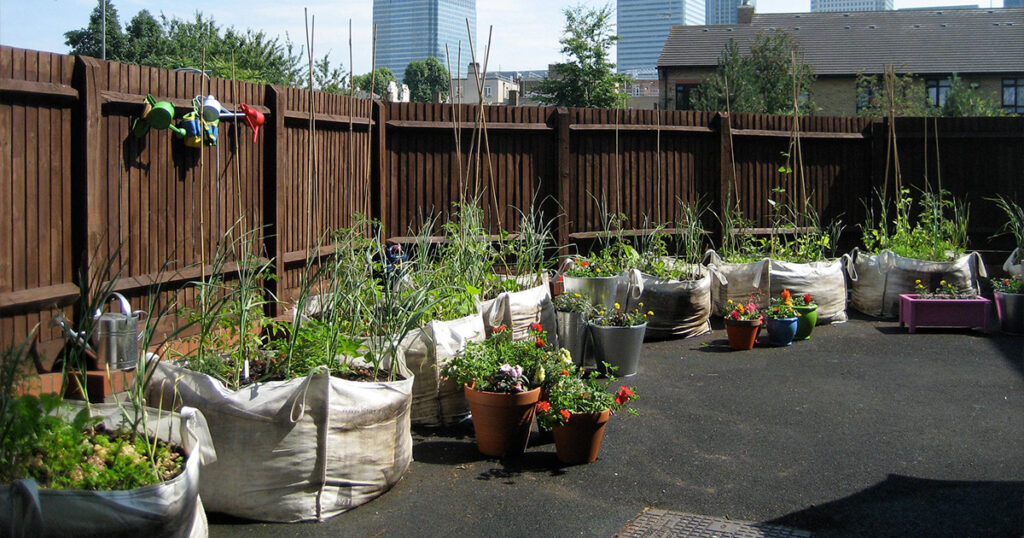
photo credit: Louise Joly
Portability and Versatility
Fabric garden beds are lightweight and easy to move, making them a portable and versatile option for gardening. They can be easily transported from one location to another, allowing gardeners to adapt to changing sunlight conditions or experiment with different garden layouts. Additionally, fabric garden beds are collapsible, making them easy to store when not in use. Their compact design and lightweight nature make them ideal for urban gardening or for those with limited space.
Roots Air Prune In Fabric Raised Beds
Unlike plastic pots where roots circle around the edges, the fabric of grow bags causes roots to “air prune” when they reach the breathable sides. This means the root tip dehydrates and stops growing, promoting the development of a dense, fibrous root system instead of a few large circling roots.
Fabric Raised Garden Beds Don’t Get Too Hot
Fabric grow bags don’t trap heat like plastic pots can, especially in sunny spots. This helps to maintain a more stable root zone temperature, which in turn helps with consistent plant growth.
Enhanced Plant Growth
The sum of all the benefits of grow-bag raised garden beds is the enhanced plant growth they promote.
Because the breathable fabric allows for better air circulation around the roots, and stimulates root growth, you get healthier and more productive plants.
Additionally, the fabric bed provides an ideal soil environment by retaining moisture while allowing excess water to drain away. This ensures that plants receive the right amount of water and nutrients, creating optimal growing conditions.
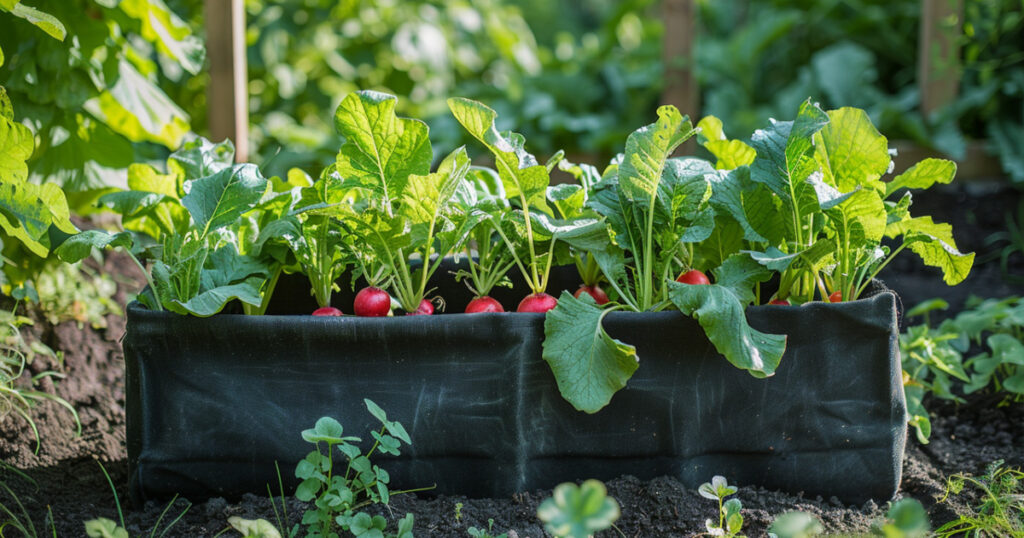
Challenges and Considerations
While fabric garden beds offer many benefits, there are also some challenges and considerations to keep in mind before using them for your raised beds.
Increased Watering Frequency
The flip side of being very porous is that fabric grow bags allow water to evaporate more quickly than in plastic pots. This means you’ll need to water your plants more often, particularly in hot and dry or windy conditions.
Grow Bags Aren’t Stable
If you go to move grow bags, they don’t hold their shape like a traditional plastic or pottery pot. If you don’t plan on moving your plants around much, then this isn’t a big deal, but if you are putting in big grow bags, this might be an issue for you.
Increased Need For Fertilization
Fabric grow bags have excellent drainage. While this is great for preventing overwatering, it also means nutrients leach out of the soil more quickly. You will want to counteract this by using a good quality organic slow-release fertilizer on a regular basis.
Grow Bags Are Not Aesthetically Pleasing
One problem with grow bags is that they only come in a few colors and are not the most attractive things to put in your garden. They are definitely functionality over form. While this isn’t an issue for someone that is all about function over looks like me that isn’t an issue, but if you have ‘a look’ that you are trying to achieve with your raised bed garden, these can be a challenge.
Step-by-Step Guide to Setting Up Your Fabric Garden Bed
Setting up a fabric garden bed is a straightforward process that can be completed in just a few steps. Follow this step-by-step guide to get started with your own fabric garden bed.
Choosing the Right Location
The first step in setting up your fabric garden bed is choosing the right location. Look for an area that receives at least six to eight hours of sunlight per day, as most plants require this amount of sunlight to thrive.
Consider the available space in your garden or outdoor area, whether it’s a patio, balcony, or rooftop. Ensure that the location is easily accessible for watering and maintenance.
Selecting the Appropriate Soil Mix
Next, select the appropriate soil mix for your fabric garden bed. Opt for a high-quality potting mix or a mix specifically formulated for raised bed gardening. These mixes provide the ideal soil environment for plants, with good drainage and sufficient nutrients.
Avoid using regular garden soil, as it may not provide the necessary aeration and drainage for optimal plant growth. Over time it will actually compact into a solid brick that your plants can’t live in.
Mix Your Own Or Buy Premade Raised Bed Mix?
Mixing your own raised bed soil mix can be a rewarding experience, allowing you to tailor the composition to suit your plants’ specific needs. However, it does require time, effort, and knowledge of different soil components. Let me not under state the amount of effort it takes to mix enough bedding mix for 15 or 20 gallon fabric pots.
On the other hand, buying premade raised bed mix offers convenience and consistency in quality. These mixes are specially crafted to promote healthy plant growth and are readily available at garden centers or nurseries.
Even if you buy generic raised bed soil, you can add some amendments to supercharge your soil. Here are some suggested things to add to your soil regardless of if you mix your own or buy premixed:
- Worm Castings: Excellent natural fertilizer, adding nutrients and beneficial microbes.
- Mycorrhizae: Beneficial fungi that form a symbiotic relationship with plant roots, improving nutrient uptake.
- Bone meal or Rock Phosphate: Natural sources of phosphorus for strong root growth and flowering.
- Kelp Meal: Provides trace minerals and growth hormones.
- Stone Dust: Additional source of trace minerals essential for healthy plants and in your food.
What Size Grow Bag Do I Need For My Garden?
Your available space will largely dictate the size and number of containers in your fabric raised bed garden. In general, most people use 10 to 20 gallon containers. You should consider the size of the plants you want to put in them, how deep their roots go, and if you will need to move them.
For plants like tomatoes and potatoes, 20 gallon containers are ideal. For plants with shallow roots like lettuces, consider lower and wider containers. I’m a big fan of small relatively shallow growing containers for things like radishes and Parisian carrots that don’t go very deep.
If you have the room, there are very large fabric raised garden beds, from 2’x2′ on up to 3’x6′ or larger.
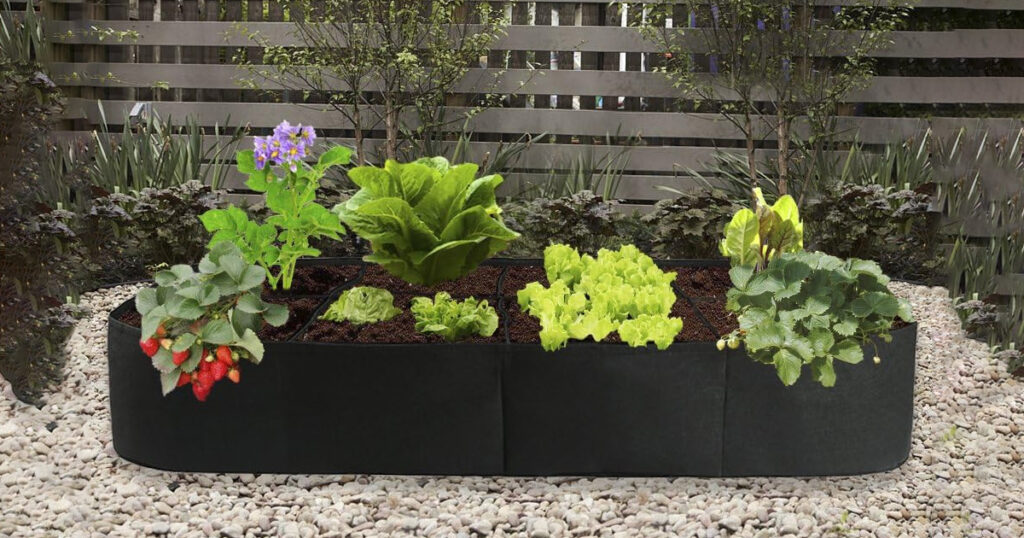
Grow Bag Suggestions
Here are some suggestions for grow bags you might want to consider for putting together your raised bed garden. These are all bags I’ve personally owned or brands that I’ve bought before and trust. All of these are available on Amazon
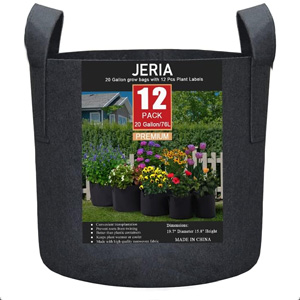
JERIA 20 Gallon Grow Bags
These bags are nice and heavy, with nice stitching. The 20 gallon size is big enough for tomatoes and potatoes. If you need a shallower ones, you can just fold down the sides.
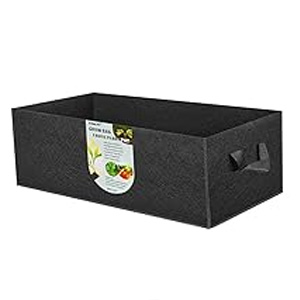
10 Gallon Rectangular Grow Bags
I got these specifically for growing things like Parisian carrots, radishes and the like. I like the fact that they are smaller, so I can move them around, but still stack them up close together.
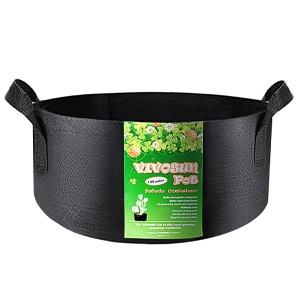
VivoSun 100 Gallon Fabric Raised Bed
Honestly, I’m not sure why they bother putting handles on this monster because at 100 gallons in size, no one is moving one of these once it is filled. At nearly 4′ across, this makes for a complete mini-garden in and of itself.
Maximizing Your Space with Fabric Garden Beds
Fabric garden beds offer the opportunity to maximize your gardening space, even in small or unconventional areas, and in areas that are hardscaped, or where the ground isn’t suitable for gardening.
Use Raised Beds That Fit Your Space
While most fabric garden beds are round, they do come in square and rectangle shapes, and in a variety of sizes. Don’t be afraid to use a variety of sizes to create your perfect raised bed garden.
Vertical Gardening Techniques
One way to maximize space with fabric garden beds is through vertical gardening techniques. Utilize PVC pipes or a trellis kit to create a vertical growing system, allowing plants to grow upwards instead of sprawling across the ground. This technique is particularly useful for vining plants, such as beans or peas, as well as for saving space in small gardens.
Companion and Inter-Planting Strategies
Another way to maximize your fabric garden bed is through companion planting strategies. Companion planting involves growing complementary plants together, such as pairing tomatoes with basil or marigolds, but can be expanded to a wide variety of plants. This practice can help deter pests, improve pollination, and make the most of limited space. Consider planting a mix of vegetables, herbs, and flowers in your fabric garden bed to create a diverse and productive garden.
Longevity of Fabric Garden Beds
Fabric garden beds are designed to be durable and long-lasting, but their lifespan depends on various factors.
Maintenance Tips
Proper maintenance is key to ensuring the longevity and effectiveness of fabric garden beds. While fabric pots need little maintenance, there are a few things to get the most out of them.
Cleaning Your Fabric Grow Bags
Regular cleaning of your fabric garden beds is essential to ensure the health and productivity of your plants. To clean your fabric grow bags at the end of the season, simply empty out the soil, rinse the bags with water, and allow them to dry completely before storing them for the next season.
This simple step helps prevent disease buildup and ensures a fresh start for each growing season.
Material Lifespan
The material lifespan of fabric garden beds can vary depending on the quality of the fabric and the level of UV exposure. High-quality fabric made from durable materials can last for several years with proper care and maintenance. However, prolonged exposure to harsh sunlight may degrade the fabric over time. To extend the lifespan of your fabric garden bed, choose UV resistant options and provide regular maintenance.
When to Replace Your Fabric Garden Bed
Knowing when to replace your fabric garden bed is important for maintaining optimal garden conditions. Signs that it may be time to replace your bed include visible signs of wear or damage, such as tears or fraying fabric. Additionally, if the fabric becomes brittle or starts to rot, it’s a good indication that it needs to be replaced. Regularly inspect your fabric garden bed for any signs of deterioration and plan for replacements as needed.
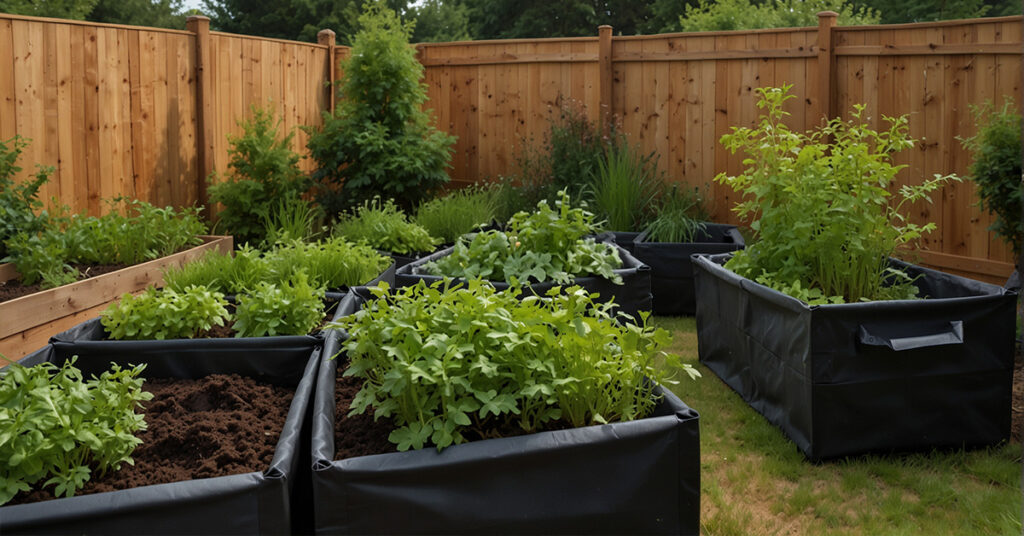
Frequently Asked Questions
How often should I water plants in fabric garden beds?
To maintain constant moisture levels in fabric garden beds, check the soil regularly and water as needed. The fabric material promotes drainage, so it’s important to ensure that the soil retains moisture without becoming waterlogged. Monitor the soil’s moisture level by checking the soil’s appearance and using your finger to test the soil’s dryness or better yet, use a moisture meter.
Can I use fabric garden beds on a balcony or rooftop?
Yes, fabric garden beds are a great option for balconies or rooftops. They are lightweight and portable, making them easy to move and set up in small spaces. The fabric material allows for easy drainage, preventing water damage to balconies or rooftops. Do be aware where the water that drains from your garden goes, and that it isn’t going onto your downstairs neighbor’s furniture.
Are fabric garden beds suitable for all types of plants?
Fabric garden beds are suitable for a wide range of plants, including vegetables, herbs, and flowers. The breathable fabric promotes healthy root growth and provides an ideal environment for various types of plants. Whether you’re growing vegetables, herbs, or flowers, fabric garden beds can accommodate your gardening needs.
How do I protect my fabric garden bed from pests?
To protect your fabric garden bed from pests, you can use a durable liner or cover the bed with a lightweight netting material. This will help prevent pests from accessing your plants while still allowing air and sunlight to reach them. Regular monitoring and practicing good gardening practices, such as removing dead leaves or debris, can also help deter pests.
Also consider co-planting your pots with plants like Marigolds that repel pests.
Conclusion
Fabric garden beds offer a host of benefits, from enhanced plant growth to improved drainage. To create your own oasis, consider their portability and versatility. While challenges like durability concerns exist, maintenance tips can help extend their lifespan. A step-by-step setup guide ensures success, focusing on selecting the right location and soil mix. Make the most of limited space with vertical gardening and companion planting. Understand when to replace your fabric garden bed, weighing DIY versus pre-made options. Embrace the adventure and explore the world of fabric garden beds to elevate your gardening experience!
